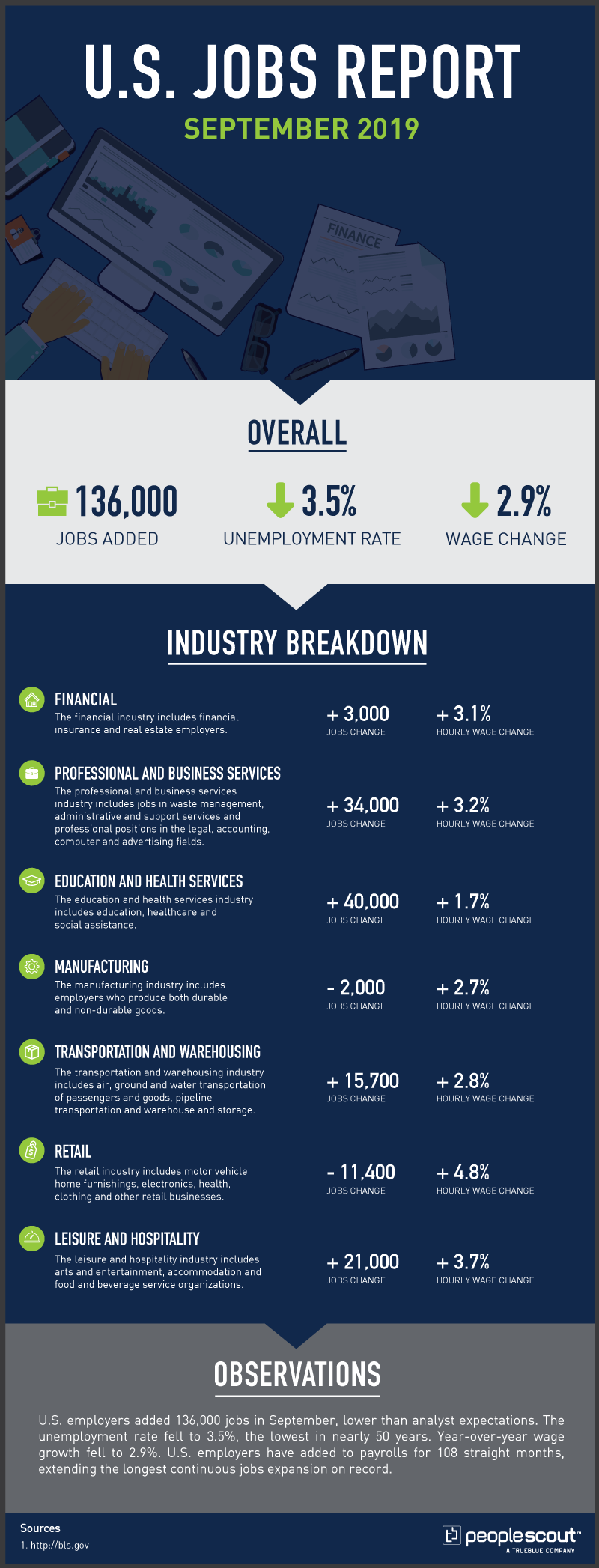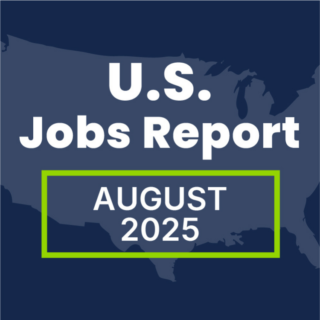The Labor Department released its September Jobs Report which shows that U.S. employers added 136,000 jobs in September, below analyst expectations. The unemployment rate fell to 3.5%, a level not seen since December 1969. Year-over-year wage growth slowed to 2.9%. U.S. employers have added to payrolls for 108 straight months, extending the longest continuous jobs expansion on record.

The Numbers
136,000: The economy added 136,000 jobs in September.
3.5%: The unemployment rate fell to 3.5%.
2.9%: Average hourly wages increased at a rate of 2.9% over the last year.
The Good
The 136,000 new jobs that were added to the nation’s economy kept the labor market on a growth trajectory which has continued for nine years. The headline news was that the unemployment rate plunged to 3.5%, its lowest level in nearly 50 years, a time before the living memory of most of the U.S. workforce.
Average annual wage gains were at 2.9%, and while decreasing from recent months, is still well ahead of inflation. A broad measure of unemployment and underemployment, which includes those too discouraged to look for work, plus Americans stuck in part-time jobs, but who want to work full-time, fell to 6.9% in September from 7.2% in August.
In September, the healthcare sector gained 39,000 jobs, which is in line with the robust increases seen in the last 12 months. Employment in professional and business services continued to trend up in September, adding 34,000 positions. The transportation and warehousing sector also expanded by 15,700 payrolls, shrugging off any major impact by the slow-down in manufacturing. And, at the end of the summer holiday season, jobs in leasure and hospitality increased by 21,000.
The Bad
The rate of job growth continues to slow. Employers have added an average of 161,000 jobs per month through September of 2019. That number is down from average growth of 190,000 jobs per month in the eight years since employment started to pick up after the last recession. The retail sector continued to hemorage jobs, with a loss of 11,400 jobs last month. Since reaching its peak level in January 2017, the retail trade has lost 197,000 positions.
Manufacturing lost 2,000 jobs in September. Last spring, manufacturers were adding as many as 25,000 jobs a month. In recent months, the average has been a few thousand. There is broad consensus that increased tariffs and the continued trade wars are taking a toll on this sector with few expecting this negative trend to change anytime soon.
The share of Americans working or searching for work last month held steady at 63.2%. The stagnation in the size of the nation’s workforce combined with a low unemployment rate not seen in nearly half a century could be a troubling sign for employers who are confronted with a shrinking pool of available talent.
The Unknown
While the unemployment rate has plunged, average annual year-over-year wage gains actually decreased in September which has left many economists perplexed. As the Washington Post reports:
“Nick Bunker, an economist at the jobs site Indeed, said that the lower unemployment rate was a good sign but that other economic indicators complicated the picture. Of particular note, he said, was that wage growth slowed from 3.2% to 2.9% in September.”
“You would expect wage growth to be much stronger given this unemployment rate,” he said. Economists have puzzled over why wage growth has remained modest since the recession despite the falling jobless rate.”
Douglas Kruse, an economist at Rutgers University, is cited in the same article and asserted that this situation cannot continue for long:
“There’s just been a large pool of people out there who are available to be employed without raising wages, but that just can’t keep going on,” Kruse said. “We’re hitting the point where we’re going to have to see wage growth, or employers aren’t going to find workers they need.”
How will employers know whether to increase wages to attract talent and, if so, how much should they be increased? Are comprehensive salary reviews needed to be adjusted with a focus on retention? How do factors such as location and years of experience impact the decision to raise wage levels? Those enterprises that have the expertise to knowledgably answers these and other related questions will have the competitive edge in a potentially tightening job market in the months to come.




